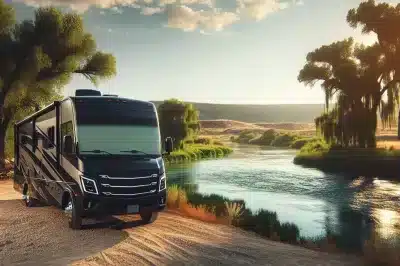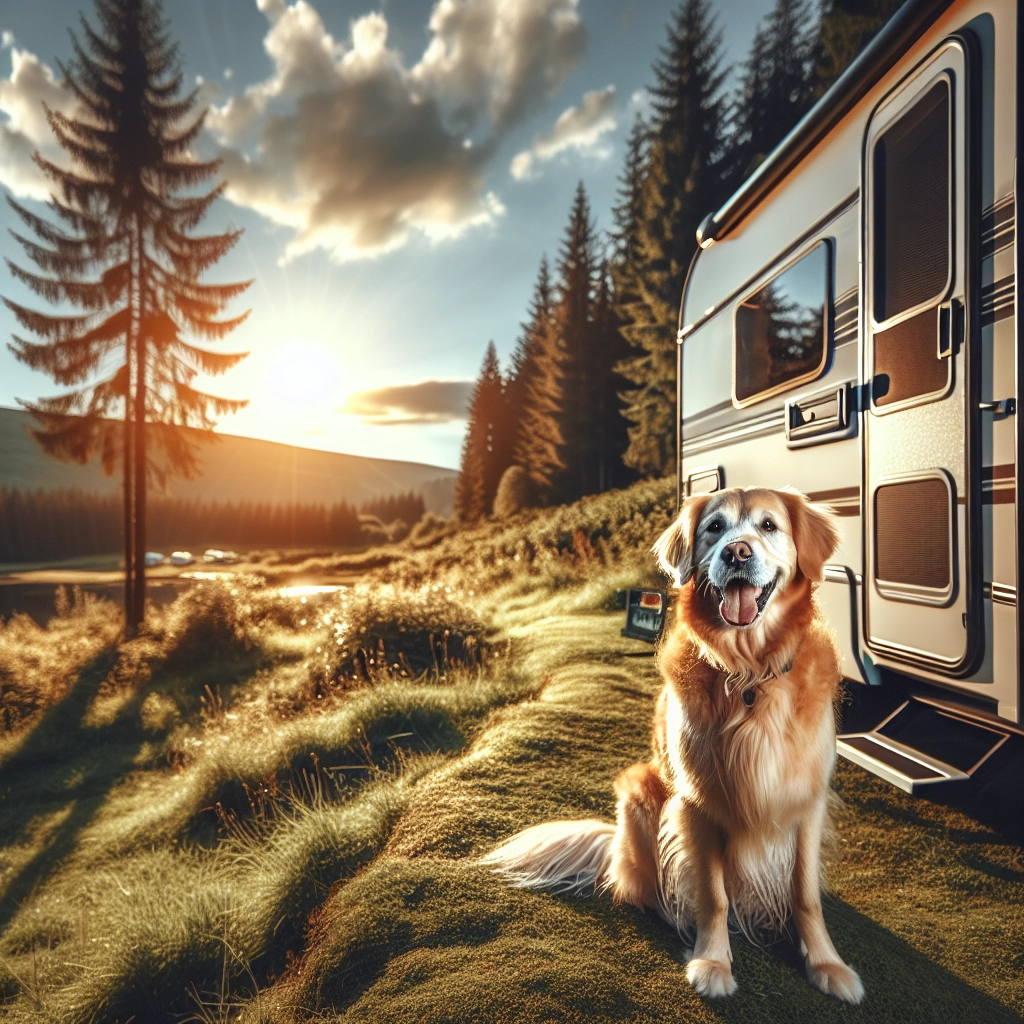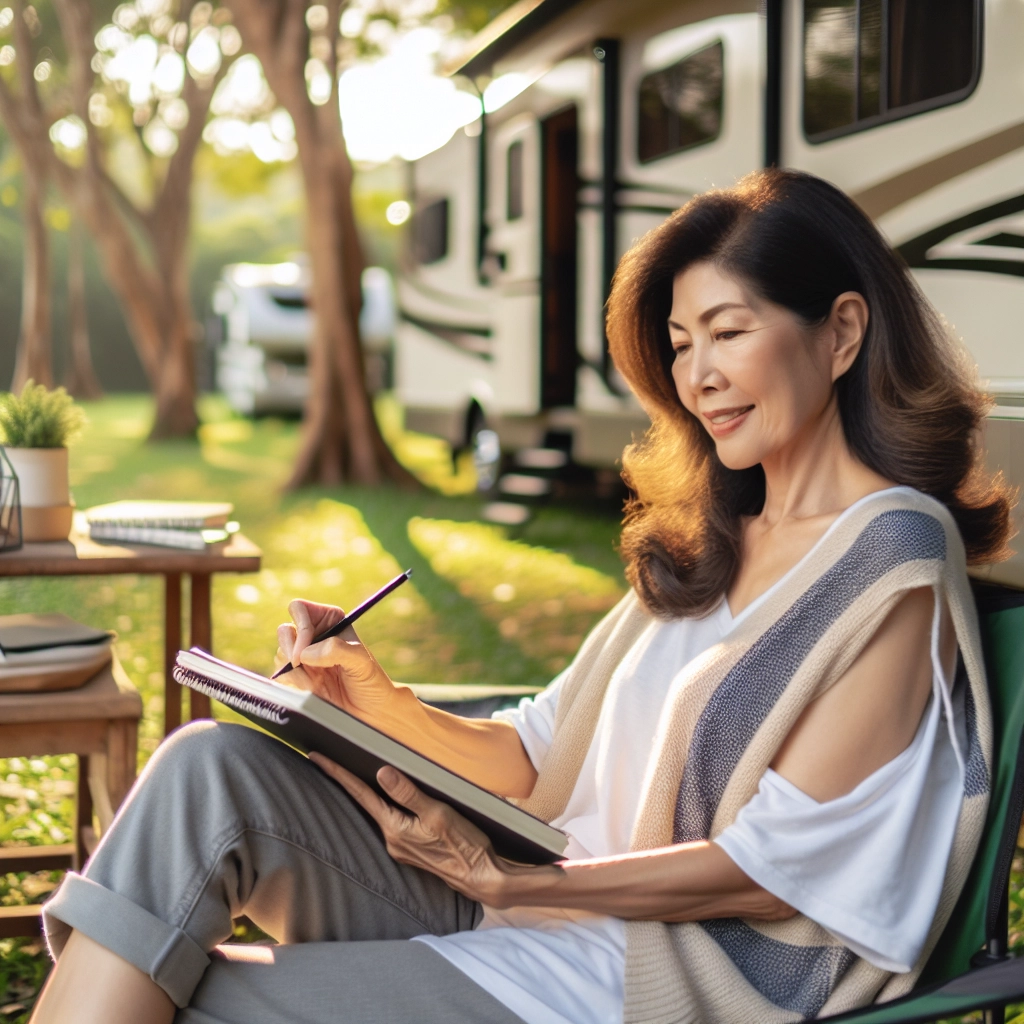Table of Contents

Harnessing the Sun: The Essentials of RV Solar Energy for Boondocking
Imagine the freedom of roaming the country in your RV, all while being kind to the environment and your wallet. That’s the promise of solar power for boondocking. With the right setup, you can capture the sun’s energy, reduce your carbon footprint, and enjoy the great outdoors without the need for noisy generators or expensive campground hookups. Let’s explore how to make the sun work for you and your RV lifestyle.
Key Takeaways: Article-at-a-Glance
- Understand the basics of solar power and how it can liberate your RV adventures.
- Discover why solar energy is a sustainable and cost-effective choice for boondocking.
- Learn how to calculate your energy needs to design a solar system that fits your lifestyle.
- Identify your RV’s energy consumption to tailor your solar power setup effectively.
- Embrace the independence that solar-powered RV living offers for off-grid exploration.
Understanding Solar Power Basics
Solar power works by converting sunlight into electricity. This process uses photovoltaic (PV) panels, which are made up of solar cells that generate an electrical current when exposed to sunlight. For RV owners, this means installing panels on the roof of your vehicle and wiring them to a battery bank where the power will be stored. The stored energy can then be used to power your RV’s electrical systems, even when the sun isn’t shining.
But how does this all come together? It’s simpler than you might think:
- Solar panels collect sunlight and convert it into direct current (DC) electricity.
- A charge controller regulates the flow of electricity to the batteries, preventing overcharging.
- Batteries store the DC electricity for use at any time, day or night.
- An inverter converts the stored DC power into alternating current (AC), which is what most of your RV appliances use.
With this setup, you can power lights, charge devices, and run small appliances without a hitch. And the best part? Once installed, the sun’s energy is completely free.
Why Solar Energy is a Game-Changer for Boondocking
Meet Sarah and John, a couple who’ve been boondocking full-time for two years. They made the switch to solar and haven’t looked back. “Our solar setup has given us the freedom to explore without the hassle of finding hookups or the noise of a generator. It’s been a game-changer,” says Sarah.
Boondocking, or dry camping, is about self-sufficiency and connecting with nature. Solar power amplifies this experience by offering:
- Quiet operation: Unlike generators, solar panels operate silently, allowing you to enjoy the peacefulness of your surroundings.
- Eco-friendliness: Solar energy is clean, renewable, and reduces your carbon footprint, making it an environmentally conscious choice.
- Cost savings: After the initial investment, the sun’s energy is free, which means no more spending on fuel or campground fees for electricity.
- Independence: With a well-designed solar system, you can stay off-grid for extended periods, freeing you from the need to plug in.
For RVers like Sarah and John, solar power isn’t just about the practical benefits; it’s about a lifestyle choice that aligns with their values and love for adventure.
Calculating Your Energy Needs for Off-Grid Adventures
Before diving into the world of solar power, it’s crucial to understand your energy needs. This will help you design a system that’s just right for you, avoiding the pitfalls of under or overestimating your requirements. Think of it as mapping out your journey before hitting the road—it’s all about preparation and knowing your destination.
Identifying Your RV’s Energy Consumption
To start, you’ll need to take stock of your energy usage. Every appliance and electronic device in your RV draws a certain amount of power, and it’s your job to figure out what that looks like on a daily basis. Here’s how:
- Make a list of all electrical devices you use in your RV.
- Note the wattage of each device, which can usually be found on the device or in the user manual.
- Estimate how many hours per day you use each device to calculate daily watt-hours.
- Add up the daily watt-hours for all devices to get a total. This is your daily energy consumption.
Remember, it’s better to overestimate your usage a bit to ensure you have enough power, especially on days when sunlight may be scarce. Once you have your total daily energy consumption, you’re ready to design a solar power system that can meet or exceed this amount, ensuring your off-grid adventures are powered reliably by the sun.
Assessing Appliance and Gadget Power Requirements
Once you’ve got a grip on your RV’s overall energy consumption, it’s time to zoom in on the specifics. Each appliance and gadget has its own power requirements, and some are more energy-hungry than others. Your fridge, air conditioning, and heating system can be the main culprits of power drain. On the flip side, LED lights and laptops are more on the modest side of energy use. To optimize your solar setup, you need to know the details:
- Check the wattage or amperage on the back or bottom of each appliance.
- Use an energy meter for devices where wattage isn’t readily available.
- Consider how the use of each appliance changes with the seasons or locations.
- Think about lifestyle changes that could affect your future power needs.
Being thorough here means you’ll be better prepared to design a solar power system that won’t leave you in the dark or with excess, unused power.

Designing Your Solar Power System
With your energy needs in hand, you’re ready to design a solar power system that’s a perfect fit for your RV lifestyle. This isn’t a one-size-fits-all situation; it’s about creating a balance between your energy needs, your travel habits, and the space available on your RV’s roof. Let’s break down the key components of your solar power system.
Choosing the Right Solar Panels
Solar panels come in various shapes, sizes, and types, each with its own advantages. You’ll find rigid panels, flexible panels, and even portable solar kits. Here’s what to consider:
- Efficiency: Look for panels with a high conversion rate to get more bang for your buck.
- Durability: Your panels should withstand the rigors of the road and a range of weather conditions.
- Size and weight: Maximize your roof space without adding too much weight to your RV.
- Cost: Balance the upfront cost with the long-term benefits and savings.
Picking the right panels is a crucial step that sets the foundation for your solar power system’s performance.
Selecting the Best Batteries for Energy Storage
Batteries are where the sun’s power gets stored for later use. The type of battery you choose can significantly impact the efficiency and lifespan of your solar power system. You’ll mainly choose between lead-acid and lithium batteries. Here’s the lowdown:
- Lithium batteries: They’re lightweight, have a longer lifespan, and provide consistent power output.
- Lead-acid batteries: These are more affordable but require regular maintenance and have a shorter lifespan.
- Capacity: Ensure your batteries can store enough power to meet your needs, with a bit of a cushion for cloudy days.
Investing in quality batteries means reliable power when you need it, especially during those long stretches off the grid.
Integrating Charge Controllers and Power Inverters
Charge controllers and power inverters are the unsung heroes of your solar power system. A charge controller protects your batteries from being overcharged by regulating the voltage and current coming from the solar panels. Meanwhile, a power inverter converts the DC electricity stored in your batteries into AC electricity that your appliances can use. Here’s what to focus on:
- Charge controller: Opt for a Maximum Power Point Tracking (MPPT) controller for greater efficiency, especially in variable weather conditions.
- Power inverter: Choose an inverter with enough wattage to handle your highest power draws, and consider a pure sine wave inverter for sensitive electronics.
Getting these components right ensures the smooth operation of your entire solar power system.
Installation Tips for Maximum Efficiency
Installing your solar power system correctly is just as important as choosing the right components. Proper installation can significantly improve the efficiency and lifespan of your solar setup. Here are some tips to get the most out of your system:
- Ensure your solar panels are angled correctly to capture the maximum amount of sunlight.
- Keep your panels clean and free of debris for optimal performance.
- Use high-quality wiring and secure connections to minimize power loss.
- Consider the aerodynamics of your RV when placing panels to reduce drag and improve fuel efficiency.
Take your time with the installation, or seek professional help if needed, to ensure your system runs at peak performance for years to come.
Best Practices for Solar Panel Placement
Where you place your solar panels can make a huge difference in how much power you generate. The goal is to maximize sun exposure throughout the day. Here’s what you need to keep in mind:
- Position panels where they will remain unshaded during peak sun hours.
- Angle panels toward the sun, considering seasonal changes in the sun’s position.
- Allow for air flow underneath to keep panels cool and improve efficiency.
- Secure panels well to withstand high winds and the rigors of travel.
- Consider tilting mechanisms to adjust the angle of the panels as needed.
- Space panels out to avoid shadowing from other panels or RV fixtures.
By optimizing the placement of your solar panels, you’ll ensure that you’re getting the most power possible from each ray of sunshine.
Wiring and Electrical Safety 101
Proper wiring is critical for safety and the efficiency of your solar power system. Electrical mishaps can be dangerous and costly. Here’s how to wire your system safely:
- Use the correct gauge of wire for the amount of current your system will carry.
- Keep wires tidy and protected from the elements to prevent degradation.
- Use fuses and circuit breakers to protect your system from overloads.
- Ensure all connections are tight and secure to prevent arcing or fires.
- Ground your system properly to protect against electrical shocks.
- Consider professional installation if you’re not confident in your electrical skills.
Respecting electricity and taking the proper precautions will keep you and your RV safe while enjoying the benefits of solar power.

Navigating the Challenges of Solar Boondocking
Boondocking with solar power is liberating, but it comes with its own set of challenges. Whether it’s weather unpredictability or system maintenance, being prepared is key to a successful off-grid experience.
Dealing with Weather Variability
Weather can be a fickle friend to solar power enthusiasts. Cloudy days, rain, and unexpected shade can all impact your energy harvest. Here’s how to handle Mother Nature’s curveballs:
- Build a buffer into your system’s capacity to account for less sunny days.
- Monitor weather forecasts to plan your energy usage accordingly.
- Consider supplemental power sources, like a small generator, for emergencies.
- Use energy more conservatively on days when solar power is limited.
- Keep your batteries well-maintained to ensure they hold a charge when you need it.
By anticipating weather changes and having a plan, you can enjoy uninterrupted power, come rain or shine.
Maintaining Your Solar Power System
Like any other part of your RV, your solar power system requires regular maintenance to perform at its best. Here’s how to keep your system running smoothly:
- Regularly clean your solar panels to remove dirt, debris, and bird droppings.
- Check connections and wiring for signs of wear or damage.
- Inspect batteries for corrosion and ensure they’re at the proper charge level.
- Update firmware for charge controllers and inverters if available.
- Have a professional review your system annually for any hidden issues.
A little bit of maintenance goes a long way in extending the life of your solar power system and ensuring it’s always ready for your next adventure.
Smart Energy Usage While Off the Grid
Managing your energy usage is just as important as generating it. Smart energy habits can help you extend the life of your batteries and avoid running out of power when you’re off the grid. Here are some tips to use energy wisely:
- Switch to LED lighting, which uses a fraction of the power of traditional bulbs.
- Unplug devices when they’re not in use to prevent phantom power draw.
- Use natural ventilation and shading to minimize the need for air conditioning.
- Cook outdoors when possible to keep heat out of the RV and reduce the need for cooling.
- Charge gadgets during peak sun hours to take advantage of maximum power output.
- Invest in energy-efficient appliances designed for RV use.
By being mindful of your energy consumption and making small changes to your habits, you can make the most of your solar power system and enjoy the freedom of boondocking without worry.
Conservation Tactics to Extend Battery Life
Maximizing battery life is essential when you’re relying on solar power. Think of your batteries as a water reservoir; the more efficiently you use the water, the longer it lasts. Here are some strategies to conserve battery power:
- Turn off appliances and lights when they’re not in use.
- Use natural light during the day and only use artificial lighting when necessary.
- Charge devices like phones and laptops during peak solar hours.
- Insulate your RV to maintain temperature and reduce heating and cooling needs.
- Regularly check battery connections and keep them clean to ensure efficient energy flow.
- Set your fridge to a higher temperature; as long as it’s cold enough to keep food safe, it doesn’t need to be at its coldest setting.
By adopting these habits, you’ll not only extend the life of your batteries but also reduce the need for frequent charging, which can be a lifesaver during extended stays in remote locations.
Practical Tips for Powering Through Low Sunlight Days
Low sunlight days can happen, especially when you’re exploring diverse landscapes and climates. Here’s how to keep your power up when the sun’s power is down:
- Plan ahead by checking the weather forecast and conserving power in anticipation of cloudy days.
- Use a portable solar panel that you can move around to catch any available sunlight.
- Supplement your solar power with a backup generator for essential power needs.
- Consider upgrading to higher efficiency solar panels that can perform better in low-light conditions.
- Limit the use of high-energy devices like microwaves and hair dryers on days with limited sunlight.
- Keep a close eye on your battery levels, so you’re not caught off guard by a low charge.
With a bit of planning and smart energy use, you can navigate the challenges of low sunlight days without sacrificing the comforts of your RV.
Solar Gadgets and Upgrades Worth Considering
As you become more comfortable with your solar setup, you might find yourself interested in gadgets and upgrades that can enhance your system’s performance and your overall experience. From high-tech to practical, there’s a range of options to consider.
Must-Have Solar Accessories for Your RV
Some solar accessories are almost essential for getting the most out of your solar power system. Here are a few that you shouldn’t overlook:
- Solar charge controller – for optimizing the charging of your batteries and protecting them from overcharging.
- Deep cycle batteries – designed specifically for storing solar power, they’re a reliable choice for your energy needs.
- LED lights – they use significantly less power than traditional bulbs, making them ideal for solar-powered RVs.
- Portable solar panels – great for when you need to park in the shade but still want to capture sunlight.
- Solar-powered fans – to keep air circulating without draining your batteries.
- Energy-efficient appliances – swap out power-hungry devices for those that are designed to work with solar power.
Investing in these accessories can make your solar-powered RV more efficient and comfortable, especially during extended off-grid trips.
Investing in Smart Energy Monitoring Tools
Knowledge is power, especially when it comes to managing your RV’s energy. Smart energy monitoring tools give you real-time insights into your power consumption and generation. Here’s why they’re worth the investment:
- Track your energy usage and solar panel output to make informed decisions about power use.
- Receive alerts when your battery levels are low, so you can conserve power or switch to a backup source.
- Monitor the health of your batteries and solar panels to address any issues before they become major problems.
- Understand your energy patterns over time, which can help you plan for future trips and upgrades.
With these tools, you can take the guesswork out of energy management and ensure your system is running as efficiently as possible.
Frequently Asked Questions (FAQ)
When it comes to solar-powered RV living, there are always questions. Let’s tackle some of the most common ones to help clear up any confusion and get you on the road to solar success.
Can you run an RV completely on solar power?
It’s a question that taps into the heart of the solar dream: total energy independence. And the answer is a resounding yes—with a few caveats. Running your RV completely on solar power hinges on having a system designed to match your energy consumption. This means enough solar panels to harness the power you need and a battery bank robust enough to store it. It also depends on your lifestyle; if you’re a tech-savvy traveler with lots of gadgets, you’ll need a more substantial setup than someone who prefers a minimalist approach.
How many solar panels do I need for my RV?
Calculating the number of solar panels for your RV isn’t just about crunching numbers; it’s about understanding your energy lifestyle. Start by tallying up the wattage used by all your devices, then factor in how many hours a day you use them. Once you’ve got your daily watt-hour total, you’ll need to consider the average sun hours in the areas you’ll be traveling. A good rule of thumb is to have enough panels to generate 30% more power than you think you’ll use, providing a buffer for those unpredictable cloudy days.
What are the best types of batteries for a solar RV setup?
When it comes to batteries, think of them as your solar system’s backbone. Lithium batteries are the gold standard, offering longevity, efficiency, and a lightweight package—but they come with a higher price tag. Lead-acid batteries are more budget-friendly but require more maintenance and offer a shorter lifespan. The best battery for you balances cost, maintenance, and capacity to meet your specific needs. Learn more about RV battery types.
How do I maintain my solar power system?
Maintenance is the unsung hero of solar power longevity. Keeping your panels clean ensures they’re absorbing as much sunlight as possible. Regularly checking connections keeps the power flowing smoothly. For batteries, maintenance means keeping them charged and, if you’re using lead-acid, topping them up with distilled water. A well-maintained system is a reliable system, so don’t skimp on the upkeep.
Is investing in RV solar power cost-effective in the long run?
Investing in solar power for your RV is like planting a tree. The benefits grow over time. Upfront costs can be significant, but the savings on campground fees, generator fuel, and maintenance add up. Plus, solar panels have a lifespan of 25-30 years, which means you’ll be reaping the rewards for decades. When you factor in the freedom to explore off-grid locations, the investment isn’t just cost-effective—it’s priceless.
In conclusion, embracing solar power for your RV is more than a financial decision; it’s a lifestyle choice. It’s about the freedom to explore, the peace of quiet sunsets, and the satisfaction of treading lightly on the earth. Whether you’re a weekend warrior or a full-time nomad, solar power offers a path to independence that’s well worth the journey. So go ahead, harness the sun, and let your solar-powered adventures begin.
- Boondocking RVs: Flexible Solar Solutions – 3 March 2024
- Renewable Energy Tips for Full-Time Boondocking RVers – 2 March 2024
- Boondocking Solar Power Systems: Sizing Options & Solutions for Motorhomes – 1 March 2024
